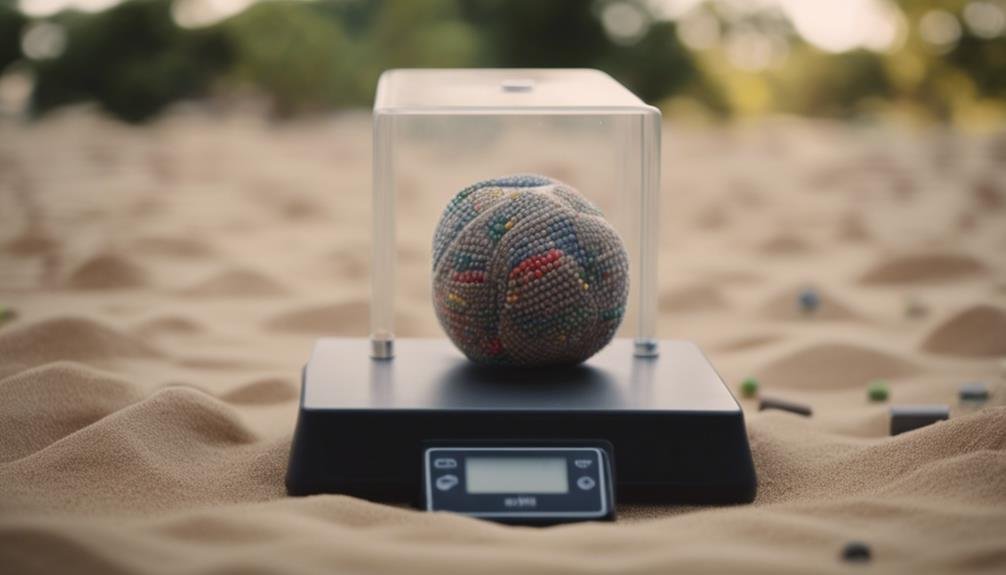When picking the right weight for your hacky sack, it’s important to match that weight with your skill level and style. If you’re starting, you might find a lighter, hacky sack easier to handle, making those initial kicks and passes less intimidating. On the other hand, as you get better, a heavier sack could give you the control needed for more complex maneuvers. Each weight impacts how the sack flies and stalls, subtly shaping your game. So, how do you strike the perfect balance to enhance your skills? Let’s explore some key considerations that could significantly shift your approach.
Key Takeaways
- Consider your skill level: beginners should opt for lighter sacks, while experienced players may prefer heavier ones.
- Define your playing style: choose a lighter sack for fast-paced games or a heavier sack for more controlled, technical maneuvers.
- Assess the weight’s impact on tricks: heavier sacks provide stability for advanced tricks, whereas lighter sacks are easier to control.
- Experiment with different weights. Starting from a medium-weight sack (around 45-60 grams) can help you gauge your comfort and performance.
- Factor in the filling material: Poly pellets are great for maintaining shape, while steel pellets or sand add the necessary weight for intricate tricks.
Understanding Hacky Sack Materials

When selecting a hacky sack, the material inside—sand, rice, poly pellets, or beans—significantly impacts its weight and how it plays. Each material offers unique characteristics that can enhance your game, depending on your preferences and level of expertise.
If you’re leaning towards options that cater more to durability and even weight distribution, you might want to contemplate poly pellets. These synthetic materials are favored for maintaining shape and consistency throughout rigorous play. This makes them a stellar choice if you’re looking for something that withstands frequent use without compromising performance.
For experienced players, the choice often narrows to either poly or steel pellets. While poly pellets offer the benefit of lighter weight and flexibility, steel pellets add a hefty weight to the hacky sack, which can be advantageous for executing intricate tricks that require a more deliberate impact on your foot or knee. The added weight from steel pellets helps maintain momentum, making them ideal for players who’ve mastered basic skills and are looking to challenge themselves with more complex maneuvers.
Selecting the right material can drastically influence your control and style, so contemplate these factors.
Assessing Skill and Style
As you evaluate your hacky sack options, consider how your skill level and playing style influence the ideal weight for your game. If you’re starting, you might find a lighter, hacky sack easier to control and handle. These lighter sacks can make it simpler for you to get the hang of basic kicks and stalls without feeling overwhelmed. On the flip side, if you’ve got more experience under your belt, a heavier hacky sack could be the way to go. It offers more resistance, which can help sharpen your skills and add a new layer of challenge to your play.
The weight of the hacky sack greatly affects how you perform tricks and manage play. Lighter hacky sacks favor players who prefer a fast-paced game with quick maneuvers. They’re less likely to tire you out and can keep the game moving briskly. Conversely, heavier hacky sacks might suit you if you’re into making precise, controlled movements, as they offer more stability and can be easier to stall on your foot or other parts of your body. Experimenting with different weights will help you find a perfect balance that matches your playing style.
Exploring Different Fillings

Let’s explore the different fillings used in hacky sacks, each offering unique benefits depending on your playing needs. Sand-filled hacky sacks are popular, especially if you’re into tricks and stalls. They’re heavier, giving you more stability, which can be a game-changer when you’re trying to nail those complex maneuvers.
Then there’s the more traditional option of plastic pellet-filled hacky sacks. These are great for consistent kicks and suit a variety of footbag tricks. The plastic pellets provide a nice balance, making them a versatile choice for beginners and seasoned players. Plus, these hacky sacks soften over time when encased in synthetic suede when encased in synthetic suede. This softening enhances their versatility, adapting to your evolving style of play.
A newer contender in the mix is hacky sacks filled with steel BBs or pellets. This filling merges the consistency of plastic pellets with added weight, perfect for bettering your stalls without sacrificing the ability to pull off a precise kick.
Choosing between sand and pellet fillings depends on whether you prioritize stalling or prefer your kicks to fly truer. Each type of filling has its merits, so consider what best fits your play style.
Impact of Weight on Performance
Understanding the different fillings and their characteristics, it’s important to consider how the weight of a hacky sack influences your performance. If you’re starting, you might find that a lighter hacky sack is much easier to control. This is because it tends to stay closer to your foot, making it simpler to manage and kick accurately without requiring a lot of force.
On the other hand, as you advance in your skills, you may prefer a heavier hacky sack. Adding weight provides more stability, which is essential for performing advanced tricks and stalls. It allows the hacky to ‘pop’ off your foot more predictably, giving you a better sense of timing and precision during complex maneuvers.
Most players find a sweet spot in hacky sacks weighing between 45 and 60 grams. This range offers a nice balance, giving you enough control for basic kicks and enough stability for more elaborate tricks. Remember, the right weight helps achieve the desired pop and stall behavior, which are critical for enhancing your overall gameplay. Experimenting with different weights can be a game-changer, helping you refine your technique and boost your performance.
Adjusting Weight for Improvement

To improve your hacky sack skills, consider adjusting the weight better to match your playing style and level of expertise. A lighter sack might be your best bet if you’re starting out. It’s easier to stall and gives you better control as you learn the basics. As you get more comfortable with basic kicks and stalls, you might find that customizing the weight of your sack allows for a more tailored experience.
As an intermediate player, you’re likely looking for a balance. A medium-weight hacky sack can provide the stability needed for complex tricks while still manageable. Adjusting weight at this stage can help bridge the gap between mastering control and executing advanced moves.
For advanced players, the ability to fine-tune the weight of their hacky sack becomes vital. Experimenting with different weights can enhance their precision and performance, especially in competitive settings. Adjusting weight isn’t just about adding or reducing; it’s about refining their feel and response during play.
Conclusion
Now that you’ve explored the materials, assessed skill level, and experimented with different fillings, you can pick the perfect hacky sack weight.
Remember, the weight impacts your control and trick execution, so aim for a sack that complements your style and skill. Start with a weight within the 45-60 gram range and adjust as needed.
Keep practicing and tweaking until you find the weight that feels just right for your game.
FAQs
What is the ideal weight for a hacky sack for beginners?
For beginners, the ideal weight for a hacky sack is around 40 to 60 grams. This weight provides a good balance of control and ease of use, making it easier to learn basic kicks and stalls without the hacky sack bouncing too much or falling too quickly.
What weight should advanced players look for in a hacky sack?
Advanced players often prefer hacky sacks that weigh between 50 to 70 grams. Heavier hacky sacks offer better stability and control for complex tricks and maneuvers. The added weight helps maintain consistent footwork and precise movements.
How does the weight of a hacky sack affect gameplay?
The weight of a hacky sack significantly affects gameplay:
- Control: Heavier hacky sacks provide better control and are less likely to bounce erratically, which is beneficial for advanced tricks.
- Ease of Learning: Lighter hacky sacks are easier for beginners to control and keep in the air, making them ideal for learning basic skills.
- Fatigue: Heavier hacky sacks may cause fatigue faster during extended play, while lighter ones are easier to handle for longer sessions.
Choosing the right weight based on skill level and playing style can greatly enhance your hacky sack experience, allowing for better performance and enjoyment.

